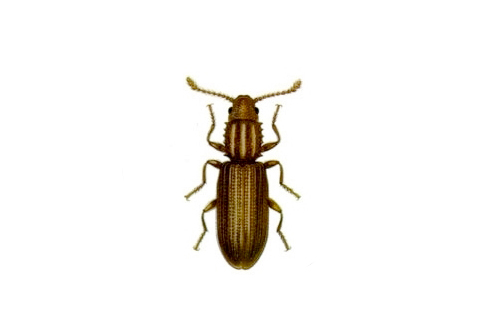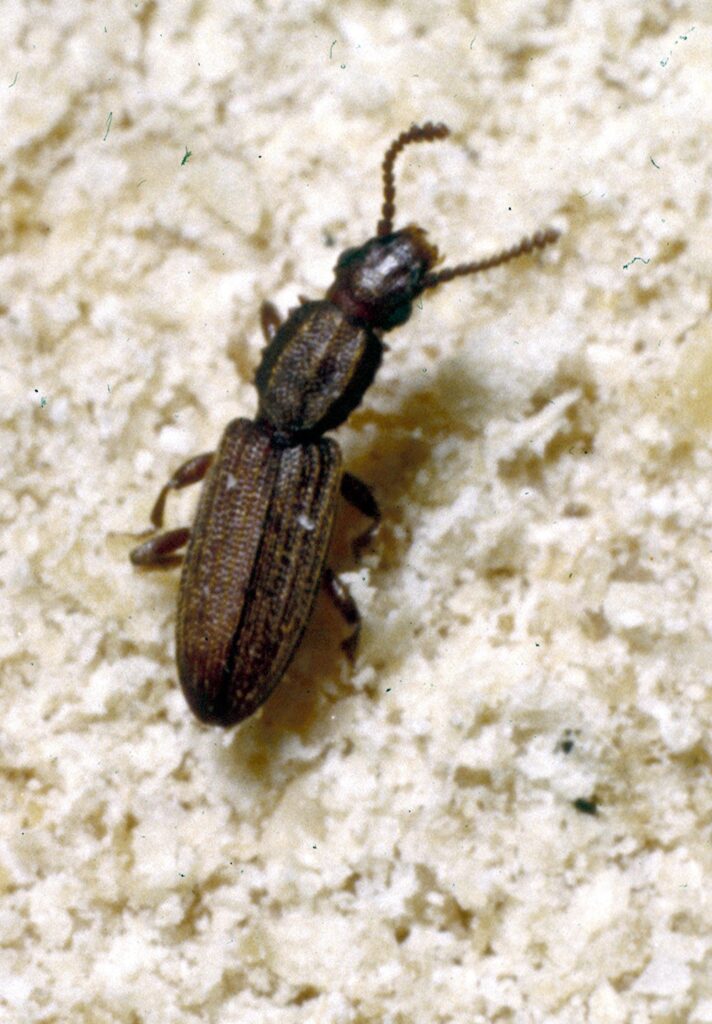Grain Beetle
What is a Grain Beetle?
The grain beetle is a small, elongated, and flattened beetle belonging to the family of pests that attack stored grains and other dry goods. They are particularly known for their ability to penetrate tightly sealed packages, compromising the quality and safety of stored foods.
How to Identify the Grain Beetle?
This tiny pest, with shades ranging from brown to reddish, generally does not exceed 2 to 3 mm in length. Despite its small size, the damage it can cause is substantial. Its flat body is specially designed to infiltrate through the smallest crevices, allowing it to access almost all types of stored products, even those believed to be well protected.
The presence of these pests is often signaled by visible damage to foodstuffs, such as perforated grains and damaged packaging, as well as the alarming discovery of adult insects and their larvae within the food. These signs are clear indicators of an active infestation, requiring quick action to limit their spread and associated damage.

Additional Information on the Grain Beetle
Pest Type
Specialized insect that attacks stored grains and dry goods, posing significant challenges for food preservation.
Appearance
These insects have a flat body, ideal for infiltrating very narrow spaces, measuring 2-3 mm and ranging in color from brown to reddish.
Lifespan
Their ability to live several months, coupled with rapid reproduction, can lead to persistent infestations if left untreated.
Habitat
Preferring dry environments rich in food sources, they infest silos, pantries, and other grain storage areas.
Diet
Feeding exclusively on grains and dry products, they can contaminate and destroy large quantities of food.
Life Cycle
Their rapid reproductive cycle, capable of producing several generations per year, necessitates constant vigilance and effective preventive measures to control their population.
Do I Have a Grain Beetle Problem?
Finding damaged grains, unusual food dust around stocks, and visible presence of insects and larvae are clear signs of an infestation. Exterminapro is ready to intervene to prevent further deterioration of your provisions.
Signs of a Grain Beetle Infestation
- Visible Damage to Grains and Stored Products: Damaged grains, often with holes or bite marks, clearly indicate the presence of these insects.
- Presence of Adult Insects and Larvae in Food: Discovering live insects or their larvae within stocks is an unmistakable sign of an active infestation.
- Compromised Packaging Integrity Due to Pest Activity: Punctured or damaged packaging often reveals the entry points used by grain beetles to access the food.


Risks Associated with Grain Beetles
The impact of grain beetle infestations extends far beyond mere household nuisances, representing a serious threat to the food industry and household food reserves. Economic losses caused by contamination and destruction of stocks can be considerable, endangering business profitability and household food security.
In light of this threat, the intervention of Exterminapro becomes indispensable. With recognized expertise in pest management and the application of effective treatments, Exterminapro offers a reliable barrier against these unwanted intruders. By choosing Exterminapro for grain beetle management, you opt for a professional solution that ensures the preservation of your food stock quality and minimizes economic losses.
What Are the Treatments to Eliminate Grain Beetles?
Exterminapro uses a combination of physical and chemical methods to eradicate grain beetle populations, while also implementing preventive strategies to avoid future infestations.
Preventing Grain Beetle Infestation
- Proper Food Storage in Airtight Containers: Using tightly sealed containers is crucial to isolating food from grain beetle attacks, preventing them from accessing grains and dry goods.
- Regular Cleaning of Storage Areas to Eliminate Food Residues: Frequent maintenance of storage spaces helps remove potential food sources for pests, reducing their attractiveness.
- Periodic Stock Inspections to Detect Any Signs of Pest Activity: Regular inspections allow for the quick identification of early signs of infestation, facilitating prompt intervention before the problem worsens.
Types of Treatments for Combating Grain Beetles
- Targeted Treatments Applied in Storage Areas: Exterminapro deploys precise strategies tailored to the specifics of each warehouse or pantry to effectively target grain beetles where they reproduce and feed. This can include approved insecticides for food environments, ensuring the safety of the food while eradicating the pests.
- Use of Traps and Specific Products for Extermination: Pheromone traps and other devices are used to attract and capture grain beetles, complementing the approach with insecticides specifically formulated to target this species without risking the quality of the stocks.
- Advice on Stock Management to Minimize Infestation Risks: Exterminapro provides professional recommendations to optimize the organization and rotation of stocks, thus reducing environments conducive to grain beetle proliferation.
How to Permanently Eradicate Grain Beetles
Eradicating grain beetles requires a professional approach. Exterminapro offers tailored solutions to treat existing infestations and prevent their recurrence. Our experts are equipped to restore the safety of your food stocks.
Intervention Process
How Much Does It Cost?
Get a Free Estimate
The cost varies depending on the extent of the infestation and the necessary treatment methods. Contact Exterminapro today for a free estimate and protect your provisions from these devastating pests.

